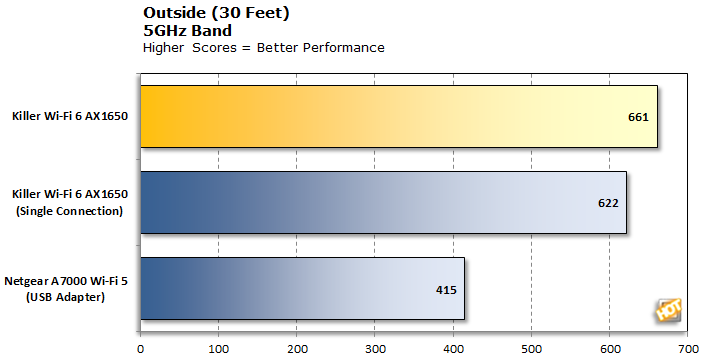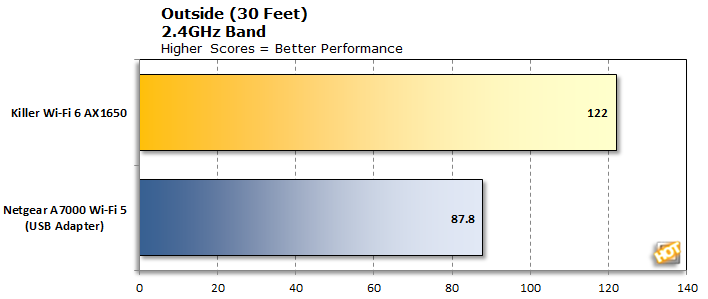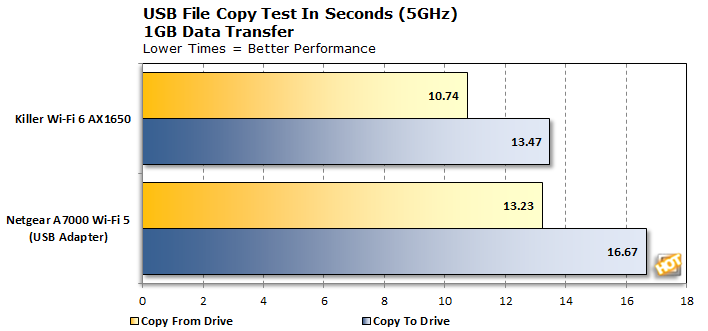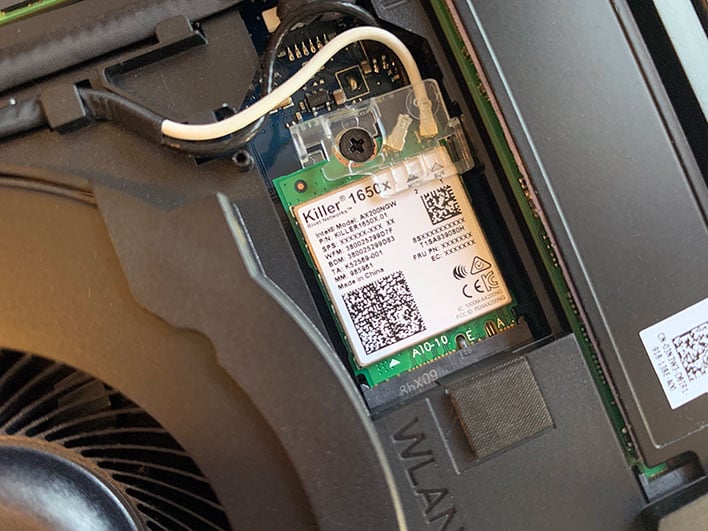Killer Wi-Fi 6 AX1650 Review: Ultra Fast, Affordable Next-Gen Wi-Fi
Killer Wi-Fi 6 AX1650: How We Tested And Performance
Test Setup
While you can purchase a Killer Wi-Fi 6 AX1650 adapter as a standalone product, it's also shipping in some PCs, starting with some of Dell's Alienware laptops. Rivet Networks and Dell sent us one of those systems, a decked out 17.3-inch Alienware Area 51m. In addition to the AX1650 module, this burly desktop replacement features an Intel Core i9-9900K processor, 32GB of RAM, NVIDIA GeForce RTX 2080 GPU, and a 512GB NVMe solid state drive.On the router side, Rivet Networks provided a Netgear Nighthawk AX8, the same one we recently reviewed. We ran some tests on this, though in our experience, the ASUS ROG Rapture AX-GT11000 is a slightly faster router. Since that is also a Wi-Fi 6 model, it is what we used for our benchmarks.
We ran one set of benchmarks on the AX1650, then disabled the adapter in the Device Manager and ran another set of benchmarks obtained from a Netgear A7000 USB Wi-Fi 5 adapter. It is one of the fastest USB wireless adapters out there. It's not an entirely apples-to-apples comparison, since the AX1650 is an internal module and the A7000 is an external one. However, this allows us to keep the rest of the hardware the same since we are using the same laptop for both sets of tests.
Simultaneous Gaming, Downloading, And Streaming
To kick things off, we ran a scenario recommended by Rivet Networks, which is to play a game while streaming a 1080p video and downloading a large file in the background. Fortnite is an ideal candidate for this—it shows the ping in real time, and is one of the most popular games around right now.
Rivet Network's suggestion is to repeat the test on a non-Killer laptop. Since we do not have another identically configured laptop, we plugged in the A7000 USB adapter and repeated tests. In the initial run, we saw similar ping times in the range of 28-32ms, for the most part. When adding a streaming video and file download to the mix, the ping only increased slightly, to around 30-34ms.
Technically, the AX1650 did a slightly better job, though not enough for us to get overly excited about. For the average gamer, it's basically a wash. This is perhaps more interesting for competitive gameplay scenarios.
Testing the 5GHz Band
The 5GHz band is the most relevant for evaluating Wi-Fi 6 versus Wi-Fi 5, because of the faster throughput. For this round of testing, we used iPerf, a popular command line tool for measuring network performance. We focused our bandwidth tests on TDP (Transmission Control Protocol) readings to measure the maximum throughput, and used UDP (User Datagram Protocol) for noting the quality of our connection, as it reports jitter and packet loss between the client and server.
Programs like iPerf require both a host machine and client PC. However, to test the max throughput of a wireless environment at 160MHz with the AX1650, we used dual servers, each with a 1Gbps Ethernet port. One is a Devil's Canyon desktop and the other is an ASUS ROG G751JY laptop, also with a GbE LAN port, both wired to the router. We then ran two separate (but simultaneous) instances of iPert on our AX1650-equipped Alienware laptop, and recorded the results.
The reason we have to do this is because a 1Gbps LAN connection does not have enough bandwidth to keep up with the full potential of Wi-Fi 6, which theoretically can scale to 2.4Gbps. A second LAN port solves this problem, at least for testing purposes.

At 3 feet from the router, the AX1650 performed even better than a typical wired connection, at 1,487Mbps. The same test on an A7000 USB adapter yielded 874Mbps. That is a 70 percent increase to the AX1650 at full throttle.
We also recorded numbers on the AX1650 when connecting to a single server instead of two. It still proved faster than the external A7000, at 944Mbps. This result surprised us, as we assumed the A7000 would fare better with the benefit of not being tucked inside a laptop. However, the AX1650 proved it's still the better option.

At 15 feet away with a clear line of sight, the AX1650 again trounced the A7000, hitting 1,343Mbps. The results when comparing a single client connection to the A7000 proved a little more evenly matched, but the AX1650 still came out ahead.

When we moved the AX1650 testbed upstairs, we saw more of the same—it again ran past what we would see with a wired GbE LAN connection, hitting 1,278Mbps, compared to the A7000 at 827Mbps.

Our outside testing was more of a challenge for the AX1650, though it still outpaced the A7000. At 30 feet away, it hit 661Mbps, just slightly better than the 622Mbps it pulled when connecting to a single server. However, both results are significantly better than what we saw with our Wi-Fi 5 USB adapter.

For our final test on the 5GHz band, we moved to the edge of an area that we consider a dead zone of sorts. This specific location is where wireless signals go to die— it's around a building and separated by multiple obstructions to the router. Moving just a few feet to the left of where we tested often causes signals to drop completely. That doesn't do us any good here, so we positioned the client PC where it could still maintain a connection to the router.
In doing so, the AX1650 managed a fast 533Mbps throughput, which is more than twice as fast as the A7000 at 241.2Mbps.

Our last graph is a cumulative roundup of just the AX1650 at different distances on the 5GHz band. This makes it easier to see how performance scales at we move further away from the router, with obstructions introduced into the mix as well.
Testing The 2.4GHz Band
The 2.4GHz band is not as interesting when it comes to evaluating Wi-Fi 6 connectivity, but we still ran the additional tests for the sake of completeness, especially since we're comparing performance to a previously generation Wi-Fi 5 adapter.

Sitting close to the router, the AX1650 hit 213.2Mbps on the 2.4GHz band. That's around 63 percent faster than the A7000, which landed at 130.7Mbps. We've actually seen better results from the A7000 in past reviews (when testing routers), but even if we plucked the best run from the bunch (166.6Mbps), it still falls well short of the AX1650.

At 15 feet, the AX1650 was nearly twice as fast as the external A7000. We're not sure if Rivet Networks, Intel, or the Wi-Fi 6 standard deserves kudos for what we're seeing in comparison to an external adapter, but whatever the case, this is impressive.

The gap was not quite as big when we moved our testing upstairs, but the AX1650 still came out well ahead of the A7000.

Moving the AX1650-based laptop outside at a distance of around 30 feet yielded more of the same—it hit 122Mbps, versus 87.8Mbps from the A7000.

At 50 feet away on the cusp of our dead zone, the AX1650 completed a clean sweep of our throughput testing by besting the A7000 one final time. Once again, there is a significant difference in throughput (these are not small victories).

And here's a look at the cumulative results on the 2.4GHz band.
1GB File Copy Test
Wrapping up our benchmarks, we recorded read and write speeds of a Lexar JumpDrive P10 USB 3.0 flash drive connected to a USB port on the back of the router. Normally we use this test to evaluate a router's performance, but we were curious if there would be a difference in transfer times over 5GHz between the AX1650 and A7000. Spoiler: there was...

In both cases, the AX1650 allowed us to transfer a 1GB test file to and from the USB drive a few seconds faster than the A7000.









